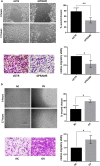PRAME promotes epithelial-to-mesenchymal transition in triple negative breast cancer
- PMID: 30602372
- PMCID: PMC6317205
- DOI: 10.1186/s12967-018-1757-3
PRAME promotes epithelial-to-mesenchymal transition in triple negative breast cancer
Abstract
Background: The triple negative breast cancer (TNBC) paradox marks a major challenge in the treatment-decision making process. TNBC patients generally respond better to neoadjuvant chemotherapy compared to other breast cancer patients; however, they have a substantial higher risk of disease recurrence. We evaluated the expression of the tumor-associated antigen PReferentially Antigen expressed in MElanoma (PRAME) as a prognostic biomarker in breast cancer and explored its role in cell migration and invasion, key hallmarks of progressive and metastatic disease.
Methods: TCGA and GTeX datasets were interrogated to assess the expression of PRAME in relation to overall and disease-free survival. The role of PRAME in cell migration and invasion was investigated using gain- and loss-of-function TNBC cell line models.
Results: We show that PRAME promotes migration and invasion of TNBC cells through changes in expression of E-cadherin, N-cadherin, vimentin and ZEB1, core markers of an epithelial-to-mesenchymal transition. Mechanistic analysis of PRAME-overexpressing cells showed an upregulation of 11 genes (SNAI1, TCF4, TWIST1, FOXC2, IL1RN, MMP2, SOX10, WNT11, MMP3, PDGFRB, and JAG1) and downregulation of 2 genes (BMP7 and TSPAN13). Gene ontology analyses revealed enrichment of genes that are dysregulated in ovarian and esophageal cancer and are involved in transcription and apoptosis. In line with this, interrogation of TCGA and GTEx data demonstrated an increased PRAME expression in ovarian and esophageal tumor tissues in addition to breast tumors where it is associated with worse survival.
Conclusions: Our findings indicate that PRAME plays a tumor-promoting role in triple negative breast cancer by increasing cancer cell motility through EMT-gene reprogramming. Therefore, PRAME could serve as a prognostic biomarker and/or therapeutic target in TNBC.
Keywords: Epithelial-to-mesenchymal transition; Invasion; Migration; PRAME; PReferentially Antigen expressed in Melanoma; Triple negative breast cancer.
Figures







Similar articles
-
Profilin 2 (PFN2) promotes the proliferation, migration, invasion and epithelial-to-mesenchymal transition of triple negative breast cancer cells.Breast Cancer. 2021 Mar;28(2):368-378. doi: 10.1007/s12282-020-01169-x. Epub 2020 Oct 12. Breast Cancer. 2021. PMID: 33047272
-
Elevated TGF-β1 and -β2 expression accelerates the epithelial to mesenchymal transition in triple-negative breast cancer cells.Cytokine. 2015 Sep;75(1):151-8. doi: 10.1016/j.cyto.2015.05.020. Epub 2015 Jun 15. Cytokine. 2015. PMID: 26088755
-
MAGE-A is frequently expressed in triple negative breast cancer and associated with epithelial-mesenchymal transition.Neoplasma. 2016;63(1):44-56. doi: 10.4149/neo_2016_006. Neoplasma. 2016. PMID: 26639233
-
FRA-1 as a Regulator of EMT and Metastasis in Breast Cancer.Int J Mol Sci. 2023 May 5;24(9):8307. doi: 10.3390/ijms24098307. Int J Mol Sci. 2023. PMID: 37176013 Free PMC article. Review.
-
Potential Role of miRNA in Metastatic Cascade of Triple-Negative Breast Cancer.Curr Cancer Drug Targets. 2021;21(2):153-162. doi: 10.2174/1568009620999201103201626. Curr Cancer Drug Targets. 2021. PMID: 33155912 Review.
Cited by
-
Targeting PRAME directly or via EZH2 inhibition overcomes retinoid resistance and represents a novel therapy for keratinocyte carcinoma.Mol Oncol. 2025 May;19(5):1471-1492. doi: 10.1002/1878-0261.13820. Epub 2025 Mar 18. Mol Oncol. 2025. PMID: 40101298 Free PMC article.
-
Peptide-Based Vaccines in Clinical Phases and New Potential Therapeutic Targets as a New Approach for Breast Cancer: A Review.Vaccines (Basel). 2022 Aug 3;10(8):1249. doi: 10.3390/vaccines10081249. Vaccines (Basel). 2022. PMID: 36016136 Free PMC article. Review.
-
Expression of Immunotherapy Target PRAME in Cancer Correlates with Histone H3 Acetylation and Is Unrelated to Expression of Methylating (DMNT3A/3B) and Demethylating (TET1) Enzymes.J Clin Med. 2024 Mar 8;13(6):1554. doi: 10.3390/jcm13061554. J Clin Med. 2024. PMID: 38541782 Free PMC article.
-
Identification of a novel five ferroptosis-related gene signature as a promising prognostic model for breast cancer.J Cancer Res Clin Oncol. 2023 Dec;149(18):16779-16795. doi: 10.1007/s00432-023-05423-5. Epub 2023 Sep 20. J Cancer Res Clin Oncol. 2023. PMID: 37728703 Free PMC article.
-
In silico recognition of a prognostic signature in basal-like breast cancer patients.PLoS One. 2022 Feb 15;17(2):e0264024. doi: 10.1371/journal.pone.0264024. eCollection 2022. PLoS One. 2022. PMID: 35167614 Free PMC article.
References
-
- World Health Organization . World Cancer Report 2014; International Agency for Research on Cancers. Lyon: IARC Press; 2003.
-
- Sørlie T, Perou CM, Tibshirani R, Aas T, Geisler S, Johnsen H, Hastie T, Eisen MB, Van De Rijn M, Jeffrey SS, Thorsen T, et al. Gene expression patterns of breast carcinomas distinguish tumor subclasses with clinical implications. Proc Natl Acad Sci USA. 2001;98:10869–10874. doi: 10.1073/pnas.191367098. - DOI - PMC - PubMed
Publication types
MeSH terms
Substances
Grants and funding
LinkOut - more resources
Full Text Sources
Other Literature Sources
Research Materials
Miscellaneous

